ADEPT | Gagauzia 2016 | Presidential 2016 | Elections 2015 | Bashkan 2015 | Gagauzia 2012 | Political Parties
Aggregated victory of dispersed opposition
Assessment of potential of political parties
Estimating the potential of preparing for participation in the 2009 parliamentary elections was one of declared collateral goals of political parties launched at the June 3, 2007 local elections. The exercise was successful, with eventual alliances and mergers of parties being based on concrete data.
24 out of 28 parties registered with the Ministry of Justice participated in the elections. It is simpler to name the parties which did not participate in elections in any of the 900 constituencies. The four parties that did not attend the elections are: Social-Political Movement New Force (SPMNF); New Moldovan National Party (NMNP); Romanian National Party (RNP); European Action Movement (EAM). The latter was registered on April 12, two weeks after the electoral campaign has started, and thus it could not attend the elections as an electoral contestant.
All other parties except for the Patria-Rodina Party of Socialists (PRPS) and the Social-Political Movement Ravnopravye (SPMR), which created the Patria-Rodina-Ravnopravye Electoral Bloc (PRREB), have participated in the electoral campaign independently. Table 1 features their acronyms for practical reasons linked to illustration of potential of parties participating in elections.
Table 1. List of parties that attended the June 3 general local elections
- DPM — Democratic Party of Moldova
- PCRM — Party of Communists of the Republic of Moldova
- OMA — Our Moldova Alliance
- APM — Agrarian Party of Moldova
- SPM — Socialist Party of Moldova
- PLJ — Party of Law and Justice
- CDPP — Christian Democratic People’s Party
- SNMPM — Speranta-Nadejda Movement of Professionals of Moldova
- LP — Liberal Party
- SLP — Social-Liberal Party
- SDPM — Social Democratic Party of Moldova
- PRREB — Patria-Rodina-Ravnopravye Electoral Bloc
- EPMGA — Environmental Party of Moldova Green Alliance
- RPP — Republican People’s Party
- RPM — Republican Party of Moldova
- LUPR — Labour Union Patria-Rodina
- CUM — Centrist Union of Moldova
- EP — European Party
- HPM — Humanist Party of Moldova
- UMSDP — United Moldova Spiritual Development Party
- PSDM — Party of Social Democracy of Moldova
- CP — Conservative Party
- NLP — National Liberal Party
- IC — Independent Candidates
Territorial branches
The electoral race in 932 constituencies of 1st and 2nd levels revealed the degree of development of territorial branches of political parties. In order to estimate the approximate development, it is enough to see in how many constituencies one or another party has registered its lists of candidates to local councillor offices. Table 2 reveals a general image of the number of offices of mayors and district, urban and rural councillors for which political parties have competed.
Table 2. Number of mandates claimed by electoral candidates
| No. | Localities | Number of mandates of district/ municipal councillors (of 2nd level) | Number of (localities) mandates of mayors | Total number of mandates of rural/urban councillors (of 1st level) |
|---|---|---|---|---|
| 1. | Chisinau | 51 | 19 | 290 |
| 2. | Anenii Noi | 33 | 26 | 322 |
| 3. | Balti | 35 | 3 | 24 |
| 4. | Basarabeasca | 27 | 7 | 93 |
| 5. | Briceni | 33 | 28 | 332 |
| 6. | Cahul | 35 | 37 | 445 |
| 7. | Cantemir | 33 | 27 | 305 |
| 8. | Calarasi | 33 | 28 | 338 |
| 9. | Causeni | 35 | 27 | 339 |
| 10. | Cimislia | 33 | 23 | 267 |
| 11. | Criuleni | 33 | 25 | 305 |
| 12. | Donduseni | 27 | 22 | 234 |
| 13. | Drochia | 33 | 28 | 346 |
| 14. | Dubasari | 27 | 11 | 135 |
| 15. | Edinet | 33 | 32 | 364 |
| 16. | Falesti | 33 | 33 | 378 |
| 17. | Floresti | 33 | 40 | 444 |
| 18. | Glodeni | 33 | 19 | 243 |
| 19. | Hincesti | 35 | 39 | 473 |
| 20. | Ialoveni | 33 | 25 | 325 |
| 21. | Leova | 33 | 25 | 269 |
| 22. | Nisporeni | 33 | 23 | 260 |
| 23. | Ocnita | 33 | 21 | 241 |
| 24. | Orhei | 35 | 38 | 446 |
| 25. | Rezina | 33 | 25 | 271 |
| 26. | Riscani | 33 | 28 | 324 |
| 27. | Singerei | 33 | 26 | 334 |
| 28. | Soroca | 35 | 35 | 387 |
| 29. | Straseni | 33 | 27 | 329 |
| 30. | Soldanesti | 27 | 23 | 253 |
| 31. | Stefan Voda | 33 | 23 | 273 |
| 32. | Taraclia | 27 | 15 | 171 |
| 33. | Telenesti | 33 | 31 | 349 |
| 34. | Ungheni | 35 | 33 | 350 |
| 35. | ATU Gagauzia | - | 26 | 378 |
| Total | 1124 | 898 | 10637 | |
| Average number of candidates per seat | >9 | >5 | >5 |
Table 3 reveals the answers of political parties[1] to needs mentioned above and the ramification of district branches of political parties.
Table 3.
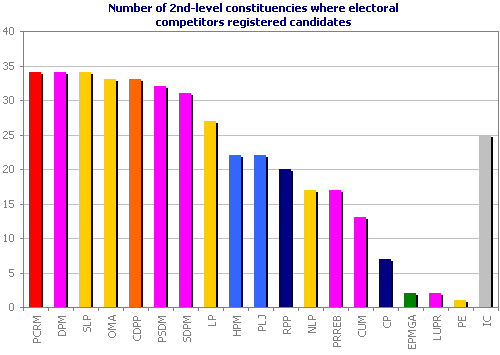
Table 3 is not relevant for conclusions; it reveals only the ambitions of political parties. In principle, the registration of some lists of candidates at district level should not be a problem for any political party. In particular, the number of candidates included in district lists could comprise at least half of the mandates disputed in the constituency concerned. In this respect, Table 3 reveals rather the very weak parties in terms of district territorial structures.
Table 4 contains much more relevant information on ramifications of district territorial structures of political parties and capacity to register lists of candidates to village and town councils.
Table 4.
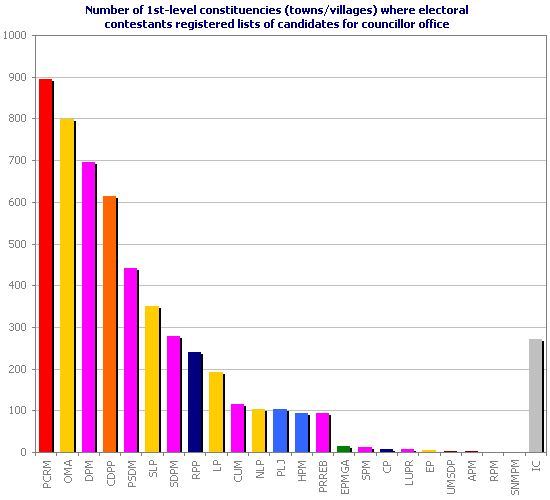
Comparing Tables 3 and 4, we observe that the contour lines revealing the number of district constituencies (of 2nd level) and town/village constituencies (of 2nd level) where parties submitted lists of candidates to these councils are changing. The change of contour lines from the two tables allows the assessment of relation between electoral ambitions of parties and real ramification of territorial branches.
Table 4 reveals that only the first five parties were capable to register lists of candidates to local council in more than half of localities. PSDM and SLP have registered their lists of candidates in more than one third of localities. SDPM and RPP have registered their lists in more than one fourth of localities. The Liberal Party, which has provided one of the greatest surprises at these elections, registered the list of candidates for councillor offices in less than one fifth of localities, ranking 9th in terms of local structures. Another five parties have demonstrated a very poor development of territorial branches, registering candidates to councillor offices in more than one tenth of localities.
As the mayor position is regarded one of most prestigious offices in localities, the territorial potential is also tested by capacity of registering as many as possible candidates to mayoral posts. Table 5 actually reproduces Table 4, and this fact confirms the verticality of human potential of parties and correctness of such estimates. The only remarkable difference for the group of parties with a strong potential (functional structures in more than one fourth of localities) is that SDPM has candidates to mayor offices (Table 5) in more constituencies than SLP, unlike candidates to local councillor positions. This fact may be described as an interesting fluctuation rather than as an indicator of development level of territorial branches.
Table 5.
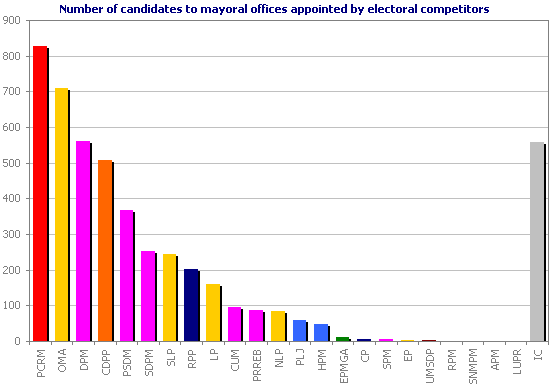
Human resources
The quantity of human potential of parties participating in the recent elections may be estimated both in Table 5 and particularly in Table 6. Examined together, the tables provide a suggestive image to understand what authentic parties are and what so-called “pitch parties” are.
Table 6.
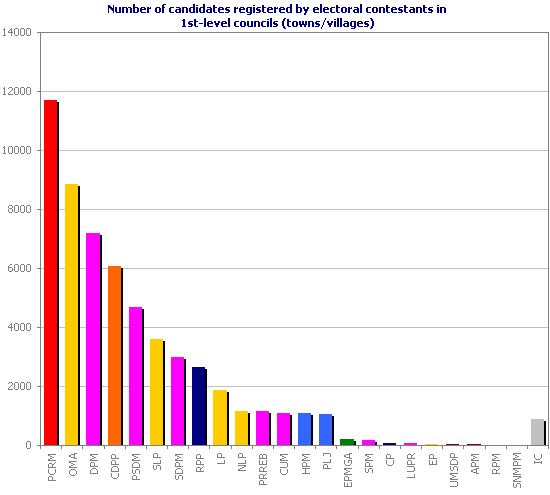
Indeed, the need of a very tight correlation between the degree of ramification of territorial branches and human potential of parties was clear a priori. However, the fact that the electoral legislation allows parties to submit lists with candidates half filled up compared with the number of mandates disputed in those constituencies leaves room for more precise estimates of human potential of parties. In this regard, it is worth to note that the strongest party — PCRM — did not nominate candidates to mayor offices in only 71 localities or approximately 8 percent. On the other hand, PCRM did not submit lists of candidates to local councillor offices in only 3 out of 898 localities.
The Liberal Party, which was capable to register approximately five times fewer candidates to local councils than PCRM, is ranked at the other pole of the group of parties with a strong potential.
Capacity of raising funds
The capacity of raising funds along with the degree of ramification of territorial branches and human potential allows for a complex estimation of parties’ potential. Table 7 reveals the data released by CEC prior to the Election Day.
However, reports on funds do not seem credible. Given the default of details, it seems that all parties have declared only the funds used for verifiable expenses. In particular, they declared the resources used to publish electoral materials, post advertising, and broadcast advertising on radio and television. The expenditures for electoral staffs, transportation and fuel for them, employment of PR experts, invitation of music stars, etc., may be easily hidden and they usually remain obscure. In this regard, the current electoral campaign is like the precedent ones. The situation will probably be the same in future, even after the new law on parties and its provisions on financing are adopted, the financing of parties and their campaigns will remain a topic of great interest, yet covered in a very approximate way.
Table 7.
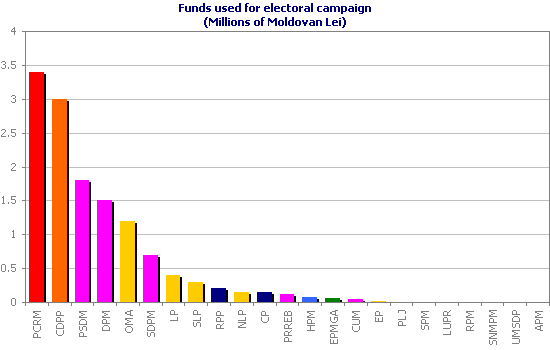
Correlation between exposed potential and results
The publication of results of elections in 2nd-level (district) constituencies has updated the real ratings of political parties. Besides the organisational-financial, human potential and doctrine affinities, the updated ratings establish new reference points for elaboration of strategies in preparation for the 2009 parliamentary elections.
Table 8.
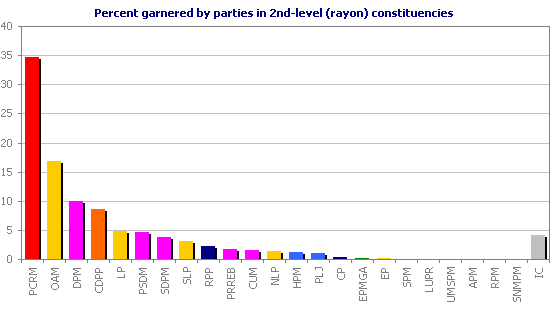
There is a very tight correlation between potential of parties estimated above and final results of elections, except for LP. Six political parties have garnered more than 4 percent of the political votes in 2nd-level (district) constituencies. These parties will be the main players to gain the mandates of parliamentarians in 2009. Another three parties — SDPM, RPP and SLP — have demonstrated a strong potential to improve their chances, so that at least to be rated as eventual partners of electoral alliances.
For example, RPP may improve its potential for sure on account of an eventual support in the Gagauz autonomy, as Gagauz Governor Mihail Formuzal enjoys support in the autonomy and he is a RPP leader. This support was not observed at the current elections because Gagauzia is only an administrative constituency at local elections, not a 2nd-level constituency like districts. SLP has demonstrated a strong human potential and a wide ramification of territorial branches.
Table 8 and precedent tables clearly reveal that the perspectives of 5–6 parties with a weak potential still are uncertain. It seems that other 8–9 parties added to the four parties that did not participate in elections have a very weak potential.
Underlined phenomena and trends set by election results
Sudden decline of PCRM rating
The political support for PCRM has declined much below expectations, from approximately 46 percent at the 2005 elections down to 34.4 percent at the 2007 local elections. The sudden decline of the rating by more than 10 percent after a slow fall trend was observed during two electoral campaigns after 2001, of about 2 percent at every ballot, are clear signs that the PCRM needs to revise its public policies, its human resources strategy and its intention announced five years ago to modernise the party, which it never did.
Table 9.
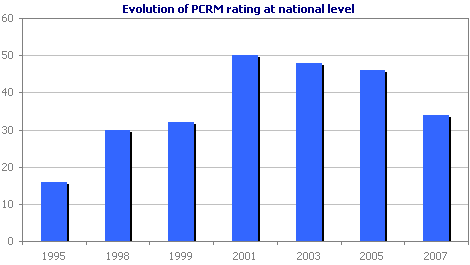
The decline of PCRM has got clear dimensions in quality terms. Thus, PCRM has gained simple majorities after the recent elections, notably more than 50 percent in 2 districts, compared with 16 in 2003; more than 40 percent in 10 districts, compared with 14 in 2003; more than 30 percent in 13 districts, compared with 4 in 2003; more than 20 percent in 9 districts, compared to no district where PCRM did not garner less than 30 percent in 2003. It may mean that promoting its staff to key leading offices in approximately one third of districts is the best the PCRM could do. In another one third of districts the PCRM could have relatively strong but not dominant positions, holding more than 30 percent.
However, the PCRM has suffered the most painful losses in symbol constituencies — Gagauzia and Chisinau. It garnered only 13 percent of the votes in Gagauzia, which is approximately two-fold less than at the 2003 local elections. It gained only 26.6 percent of the votes for the Chisinau Municipal Council, compared with 43.7 percent in 2003.
Table 10.
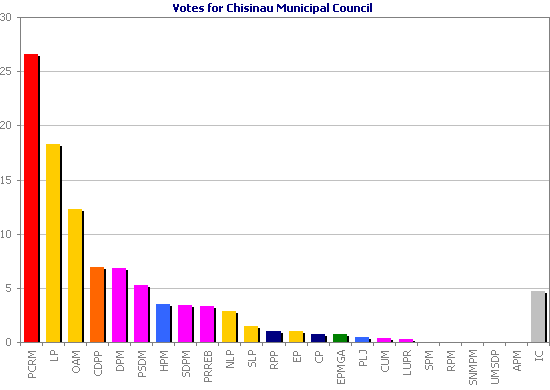
As a result, the PCRM has won only 16 out of 51 mandates in the Chisinau Municipal Council, which is less than one third, and it has no chances to co-participate in a ruling majority.
Table 11.
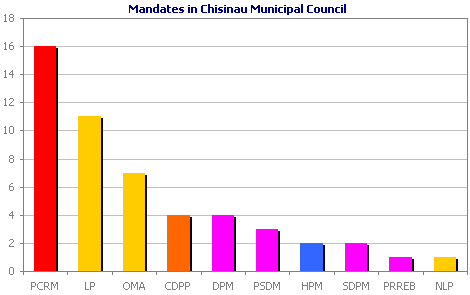
Gaining the runoff vote for the Chisinau mayor office could be the only consolation for PCRM. The PCRM candidate has gained a relatively modest result of only 27.7 percent in the first round of elections, compared with 41 percent in 2003.
Table 12.

The victory of the PCRM candidate at the runoff vote is less and less unlikely, even if opposition political parties disperse themselves. Voters of opposition forces count for 2/3 compared with PCRM supporters. Thus, the mass media affiliated to PCRM has libelled the rival of the PCRM candidate, trying to inoculate the fear toward his eventual victory as a motivational factor to gain the support of the PCRM candidate.
Performance of opposition — consequence of “April 4 vote”
The results of recent elections reveal indeed an “aggregated” victory of the “dispersed” opposition. New trends that have been earlier observed are being consolidated now. They disadvantage the ruling party in particular and encourage the opposition in general.
Changes and new significant trends are consequences of the “April 4 vote” for sure. Expectations linked to manifestation of effects of the “April 4 vote” have not become true. The “intransigent” opposition did not defeat the “constructive” opposition, nor did the opposite happen. Thus, the recent elections reduced the need of speculating this problem. The ascension of a new political leader, perhaps of a new movement, is the authentic effect of the “April 4 vote” manifested and confirmed at the recent elections. But they come out from extra-parliamentary opposition, just like the proverb — where two are fighting, the third wins.
Although the decline of the rating of any ruling party imminently increases the rating of the opposition, the relatively good performance of the opposition is based on many reasons in this case. They deserve to be analysed on segments:
1. The “constructive” opposition made up by DPM and CDPP have gained an honourable result, even better than expected. The rating of DPM has grown by 2 percent per country, from 7.7 percent in 2003 up to 9.7 percent in 2007. DPM has generally doubled its electoral support in the Chisinau municipality, from 2.9 percent in 2003 up to 6.8 percent in 2007. It may be said that the “April 4 vote” did not affect at all the DPM. As declared “centrist” party, the DPM has openly committed itself in 2002 to persuade and support the eventual “modernisation” of PCRM by conversion to socialism or social democracy. The eventual “betrayal” of DPM was predictable in the eyes of the anti-communist press and, for this reason, the DPM was not so criticised like the other “treacherous” parties participating in the “April 4 vote” for re-electing the PCRM leader Vladimir Voronin as chief of state.
The better score of DPM at the recent elections is based on several reasons, with the main causes being linked to the remarkable campaign held by DPM candidate to the Chisinau mayor office, Vladimir Filat; attraction of notorious personalities of public life such as “the father of Moldovan social democracy,” Oazu Nantoi, in DPM, etc.
CDPP has garnered 8.5 percent of the votes on country, compared with 8.9 percent at the 2003 local elections and 9.1 percent at the 2005 parliamentary elections. It may be said that the CDPP has maintained its rating in the margin which does not leave room for forecasting significant recoil. The result rather reveals the stability of rating and a certain performance. CDPP has constantly been in the past two years the favourite target of anti-communist media, which maintained the accusations of “betrayal” for the “April 4 vote” on agenda.
The result of CDPP nationwide conceals the impact of the “April 4 vote”. This impact clearly manifests in the inversion of preferences for this party in the Chisinau municipality and all country. The rating of CDPP was approximately two times higher in Chisinau than in other localities at all precedent elections. Thus, the CDPP has garnered 15 percent of the votes in Chisinau at the 2003 elections and only 7 percent in the rest of the country. But things have changed at the recent elections, as the CDPP gained 7 percent of the votes in Chisinau and 8.9 percent in the rest of the country.
The democratic media, which does not like the CDPP, has exploited at maximum the conflicts insides this party — the withdrawal of three MPs from the CDPP parliamentary faction; dissolution of the CDPP faction in the Chisinau Municipal Council. These internal conflicts were a consequence of the “April 4 vote”.
The conflicts caused by the adoption and implementation of the new broadcasting legislation, the privatisation of the municipal broadcasters Antena C and Euro TV were also presented as negative consequences of the “April 4 vote” and of the cooperation between CDPP and PCRM. Finally, the modification of the Parliament’s Regulation together with the PCRM faction, ceasing this way the live broadcasting of plenary sittings of legislature, had negative echoes particularly among electors in Chisinau who seek better information.
For comparison, all accusations brought by media against CDPP could not be imposed to the other component of the constructive opposition — DPM. Therefore, the DPM has doubled its rating, while the rating of CDPP has declined two-fold in the Chisinau municipality.
2. The “intransigent” opposition has gained an honourable score in general. As expected, it has criticised the ruling party and the “constructive” opposition for the April 4, 2005 “betrayal”.
The Our Moldova Alliance (OMA) has gained 16.7 percent of the votes nationwide, compared with 20 percent garnered by Electoral Bloc Social Liberal Alliance Our Moldova (EBSLAOM) at the 2003 local elections. The score of OMA is three-fold lower than the one claimed by this party. Nevertheless, this confirmed the status of OMA as “the strongest opposition party”.
For certain reasons, the route and perspectives of the “intransigent” opposition deserves a concise summary. EBSLAOM was initially an electoral bloc made up of six parties to participate in the 2003 general local elections: Alliance of Independents (AI), Social Democratic Alliance (SDA), Liberal Party, Environmental Party Green Alliance of Moldova (EPGAM), Democratic People’s Party (DPP) and Party of Reform (PR). Immediately after the 2003 elections, three of the six parties, AI, SDA and (old) Liberal Party have merged into a new political entity called OMA. The latter together with DPM and SLP created the Democratic Moldova Bloc (DMB) in 2004 to participate in the 2005 parliamentary elections. The failure of DMB to defeat PCRM has disintegrated the bloc immediately after the parliamentary elections, followed by a series of further divisions of OMA. As a result, the Party of Social Democracy of Moldova (PSDM) was built on the former SDA and the National Liberal Party (NLP) was built on basis of the old Liberal Party. The Party of Reform has seized the temporary disappearance of the old Liberal Party (2003–2005), taking over this name and making its debut at the current local general elections, providing the great surprise this way.
These details follow one goal — to show that all former members of the SLAOM of 2003 and of the DMB of 2005 have reached after the June 3, 2007 local elections the point from which they started before the 2003 local elections. Really, taken together the former components of SLAOM have garnered more votes at the recent elections, notably 23 percent compared with 20 percent in 2003.
The former members of the DMB of 2005 have gained more votes at the recent elections than the bloc won in 2005 — 35.8 percent versus 28 percent. The difference is clear. It brings to and end the useless talks that MPs elected on behalf of DMB have won their mandates thanks to OMA, whose leader has brought them to the Parliament like a kangaroo in its pouch. The results of parties which have immediately quit the DMB: DPM — 9.7 percent, SLP — 3.2 percent, and of those which withdrew from OMA later: PSDM — 4.77 percent; NLP — 1.3 percent, reveal indeed that nobody owes anything to anybody. All have the parliamentary representation share they deserve. At present, after the votes of citizens have tested the potential of every party, one would welcome the change of intransigent optic, its inversion in exchange for coalitions and mergers, but this time on the basis of criteria capable to consolidate their potential.
One essential observation is that in the case of OMA too the preferences of the electorate in the capital and the rest of the country have also inversed like in case of CDPP. Thus, SLAOM gained 25.1 percent of the votes at the 2003 elections in Chisinau, compared with 12.3 percent at the recent elections, with the OMA rating being two-fold lower than previously. OMA has garnered 17.9 percent of the votes in the rest of the country. A direct consequence of asserting this fact is a statement by OMA leader AMN Serafim Urechean: “Voters’ option requires that approaches determined by the 4 April 2005 vote are left for history.” This is true, because the LP is the main operator and beneficiary of inversion of preferences toward OMA and CDPP.
3. Extra-parliamentary opposition, particularly one of many extra-parliamentary parties — Liberal Party — provided the greatest sensation on June 3, 2007. LP ranked 2nd in the Chisinau municipality, losing to the ruling party only.
The success of LP is impressive for its disproportion. Really, the LP candidate to the Chisinau mayor office has gained 24.3 percent of the votes in the first round; the list of LP candidates to the Chisinau Municipal Council won 18.3 percent of the votes; 4.8 percent in 2nd-level constituencies on country; 1.8 percent in 2nd-level constituencies outside of the Chisinau municipality. This range provides precise figures to confirm a fact — the great success of LP is particularly due to its candidate to the Chisinau mayor office, Dorin Chirtoaca, LP deputy chairman.
The electoral success of LP compared to organisational, human, financial, etc. resources mentioned above outlines more the disproportions, indicating the consolidation of a new trend of electoral conduct of citizens. This trend appeared at the 2005 new municipal elections in Chisinau and consolidated at the recent scrutiny. The trends work most for those who have intuition and intelligence to use them. The modest results registered by LP in the rest of the country are some reverberations of the success gained in Chisinau. However, it is worth to note the efforts made by LP in the past two years to consolidate its territorial branches and to attract a human potential capable to spread in territory the success harvested in capital.
A proof for this conclusion is the fact that before Dorin Chirtoaca joined the LP in 2005, this party lacked a minimum potential to participate at least formally in the 2005 parliamentary elections with a list of candidates, the way it has done in 2001, when it gained 0.67 percent of the votes as part of the Electoral Bloc Faith and Justice.
The rounds of success of Dorin Chirtoaca deserve a short summary, as well as of its objective and subjective components: a) the “April 4 vote” divided the opposition into “constructive” and “intransigent” elements involved in disputes and mutual accusations on background of governing of a dominant party; b) the vacancy of the Chisinau mayor office occurred in 2005 has challenged new elections, which apparently were held in vain and were invalidated four times because of the absenteeism, but it provided an unimaginable frame for political advertising and make names known; c) personal skills of Dorin Chirtoaca — knowledge, intuition, coherent language accordingly to expectations of a significant segment of citizens, the sincere self-seeking of an intellectual young man, etc.
These factors have constructively attracted the support of more than 45,000 voters by the end of the sterile electoral marathon held in four rounds. The increase in Chirtoaca’s rating in less than half a year, from scrutiny to scrutiny, from 7 percent to 25 percent to 35 percent later was also due to the loss of interest of Moldovan political elite for the office of Chisinau mayor with a mandate of 1.5 years only, from December 2005 till the June 2007 general local elections.
Conclusions
- The results of the June 3, 2007 local elections mark the beginning of a special situation, with eventual significant impacts on Moldova.
- The decline of the PCRM rating down to one third of the electorate’s support makes the ruling party feel uncomfortable. PCRM has made only political enemies during the absolute domination on political scene. Its conduct aimed at persecuting the opposition candidates, including of the “constructive” opposition at the recent elections has rejected all potential partners of coalitions.
- In this situation, PCRM will have to draw appropriate conclusions and choose another conduct to inhibit the negative trends. Achieving the long-declared modernisation of PCRM and co-participating in building a socialist political or social-democratic pole would be the alternative of a policy on more severe attitudes toward political opponents and confrontation between central and local authorities controlled by opposition. The first option could have negative consequences on Moldova, while the second one seems to be too nice a dream to become true.
- Eventual attempts by the PCRM to regain its electorate will face difficulties. An analysis of data on participation and distribution of votes between electoral competitors reveals a new essence of electoral conduct, which cannot be explained by absenteeism only. The change is due to public policies promoted by ruling party. Truly, electors hold the right to ask why a communist, not liberal party must declare and hold a “liberal revolution” if this is needed?
- The incoherence of actions could easily disperse the “aggregated” victory of opposition. Eventual coalitions of opposition parties to make up majorities and elect the leadership in most of districts and Chisinau municipality could manifest in various ways. The perspective of reproducing small ADRs[2] at district level should make opposition leaders tremble. On the other hand, maintaining a balance of relations between district administrations controlled by opposition and central government could help preserve the trends observed at the recent elections until the 2009 parliamentary elections. Anyway, they favour the opposition in general.
- Eventual attempts by the opposition to shake the fundament under the “vertical of state power” at district level could trigger reactions from the ruling party. Radicalisation of the power-opposition relations on background of bitter criticism of government for state of mass media, electoral process, etc. would justify the refusal of the European Union to award a higher status to relations with the Republic of Moldova. As a result, the ruling party could revert to open CIS oriented policies, as stated on a number of occasion intention that seems to be confirmed by recent statements.
- The opposition shall take measures to stop the dispersion. This will be impossible without consolidating the new trends observed at the recent local elections. Traditions of Moldovan political culture leave little chances of optimism in this respect, with capacity of cooperation between opposition leaders who “created conditions” for new trends and their exponent remaining a big problem.
- In all likelihood, the political instability will grow until the 2009 parliamentary elections. This is risky both for political class and for electors who might end up but with “lost illusions”.
- ↑ (Traditional) colours have been chosen accordingly to doctrines of parties: communist — red, socialist or social-democratic — pink, liberal — yellow, Christian-democratic — orange, conservative — dark blue, etc.
- ↑ ADR — Alliance for Democracy and Reforms created after the 1998 parliamentary elections combated the negative consequences of the August 1998 financial crisis in Russia on Moldova economy, with the price of own rating, preparing the comeback of PCRM to power in 2001.


